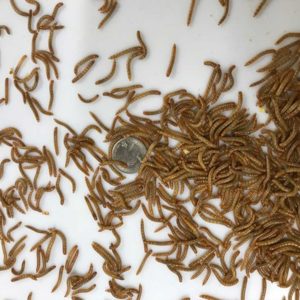If you’re a reptile owner, you know that providing a healthy diet is essential to your pet’s long-term well-being. One of the biggest decisions you’ll face is choosing the right live feeders—and for many, it comes down to two popular options: mealworms and superworms. At first glance, they may seem interchangeable, but there are key differences in size, nutrition, and suitability depending on your reptile’s species and life stage.
Let’s break it all down so you can make the best choice for your scaly friend.
Size and Life Stage: Match the Worm to the Reptile
Not all worms are suitable for every reptile, especially when it comes to size. Mealworms are smaller—typically about 1 inch in length—making them ideal for hatchlings, juvenile reptiles, and smaller species like geckos, anoles, and young bearded dragons.
Superworms, on the other hand, can grow up to 2 inches long and are considerably thicker. This makes them a better option for adult reptiles or larger species like monitors, tegus, and mature bearded dragons.
Feeding a superworm to a small or young reptile can result in choking or digestive issues, so always size-match feeders to your pet.
Nutritional Differences: Breaking Down the Stats
Though both worms are good protein sources, their nutritional profiles vary:
Nutrient : Mealworms vs. Superworms (per 100g)
Protein ~20% ~19%
Fat ~13% ~17%
Fiber ~2% ~3%
Moisture ~62% ~59%
Mealworms are slightly lower in fat, making them better for reptiles that are less active or prone to obesity. Their crunchy exoskeleton, however, contains more chitin, which can be harder to digest in large amounts.
Superworms have a higher fat content, making them an energy-dense treat for reptiles that need a boost. They also contain more moisture, which can help with hydration—but they should be given in moderation to avoid weight gain.
Behavior and Feeding Response
Mealworms tend to be less active than superworms. They’ll wriggle around, but not enough to grab attention from more sluggish or shy feeders.
Superworms, on the other hand, are extremely active and stimulating. Their constant movement makes them great for triggering hunting instincts in reptiles, especially those that are food-motivated. However, because superworms can bite, they should never be left unattended in the tank, especially with reptiles that aren’t actively feeding.
Which Worm Wins? It Depends on Your Reptile’s Needs
For younger or smaller reptiles: Mealworms are a safe and nutritious staple.
For active, adult reptiles: Superworms can add variety and stimulation.
For weight-conscious pets: Stick with mealworms due to lower fat.
For hydration support and enrichment: Superworms provide more moisture and movement.
Final Thoughts: Quality Matters
No matter which feeder you choose, the quality and source of the worms make a big difference in your reptile’s health. Always buy from a trusted supplier that provides clean, gut-loaded worms raised in sanitary conditions.
Sunshine State Worms offers premium live mealworms and superworms that are healthy, active, and shipped fresh to your door. With a reputation for quality and care, Sunshine State Worms ensures your reptile gets the best nutrition and you get peace of mind. Order our feeder worm products today!
—————
Frequently Asked Questions: Mealworms vs. Superworms (FAQ)
Q1: Can I feed both mealworms and superworms to my reptile?
Yes, alternating both can provide variety, but adjust based on size and nutritional needs.
Q2: How often should I feed superworms to my reptile?
Superworms are best used 2–3 times a week as a treat, not a daily staple.
Q3: Do I need to gut-load mealworms and superworms before feeding?
Yes, gut-loading 24–48 hours before feeding ensures optimal nutrition transfer to your reptile.
Q4: Can superworms bite or harm my reptile?
They can bite if left in the tank. Always supervise feeding and remove uneaten worms.







